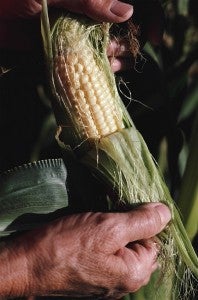No illusion here. Optical sensors can save farmers money.
 Precision agriculture is on its way to becoming mainstream. First, farmers need tools and technologies that make this kind of smart farming dramatically easier.
Precision agriculture is on its way to becoming mainstream. First, farmers need tools and technologies that make this kind of smart farming dramatically easier.
Optical sensors are one of the most promising technologies available now. This technology is very exciting because it helps farmers save money on fertilizer – and improve crop yields.
Optical sensors are devices attached to a farmer’s fertilizer applicator. As the farmer travels across the field applying fertilizer, the technology reads how green or healthy the crop is, and it applies the right amount of fertilizer in accordance with each plant’s needs.
For example, a very green corn plant would get only a little fertilizer, while a plant tinged with yellow would get more fertilizer to help it catch up with its neighbors. That’s precision agriculture at its best.
Despite the benefits, farmer adoption of data-centric technology is low. One barrier appears to be cost – about $20,000 to outfit one sprayer or spreader. Farmers may also be reluctant to invest the time to learn a new technology.
Smithfield Foods, the largest pork producer in the world, and Murphy-Brown, its hog production subsidiary, understand the importance of improving fertilizer use – and the challenges farmers face in increasing fertilizer efficiency. One reason: Murphy-Brown has 15,000 acres of its own cropland in eastern North Carolina.
Murphy-Brown purchased an optical sensor called GreenSeeker for its farms in 2012, and the equipment paid for itself in just one year. The results convinced the company to offer the technology to local grain farmers so they could test it for themselves – and help spread the word about spreading fertilizer efficiently.
In collaboration with EDF, Murphy-Brown developed an innovative plan to buy five GreenSeekers and lend them to local farmers who provide grain for the company’s hog operations. Murphy-Brown also hired an agronomist to help farmers master the new technology.
The plan was a hit, and five farmers quickly signed up. The equipment is being installed now to prepare for fertilizer application to the winter wheat crop. Later this year, farmers will use their GreenSeekers on corn and other crops.
Farmers pay only $1,000 for installation, and they can use the borrowed equipment free of charge for one year. After that, they can purchase the technology from Murphy-Brown – or give it back to the company. The decision is up to the farmer.
Here’s another cool thing about the program. Murphy-Brown will offer the same deal to five other farmers next year – and five new farmers every year until 2020. If a farmer likes the technology and buys it from Murphy-Brown, that’s great. The company will buy more optical sensors to loan out.
Murphy-Brown will collect data on results using the technology and share it with participating farmers. EDF will also work with an independent crop consultant to test the technology and make sure it is calibrated properly.
I believe Murphy-Brown’s plan will help farmers spread the word about the benefits of smart farming technologies like optical sensors. The company’s upfront investment in the equipment will pay off for local farmers and the environment for many years down the road.












